Source: David C, Bankless; Translator: Deng Tong, Golden Finance
Following the Ethereum Foundation’s recent announcement of the expansion of L1, Vitalik published an article on Friday titled “Simplifying L1”, which explains how Ethereum can simplify and strengthen its base layer to cope with long-term development.
For Vitalik, scalability is not enough - if Ethereum wants to become a "platform for storing civilization assets and records", it must also remain easy to understand, maintain and secure. He believes that it is time to abandon the bloated architecture, rethink the core system, and replace the EVM with a simpler system. His goal: to build an Ethereum that is almost as simple as Bitcoin in five years.
Here is the tl;dr - covering the core ideas of simplifying consensus, execution, etc.
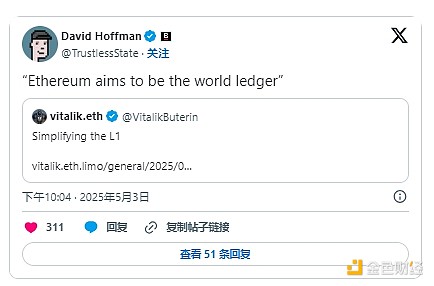
Why Simplicity Matters
For Vitalik, simplicity is not just about simpler code, but about making Ethereum more powerful. The more people can understand and use the protocol, the more secure, decentralized, and adaptable it is.
He uses Bitcoin as an example: its base layer is so streamlined that even a high school student (he believes) can build a client. This simplicity helps it remain stable, widely auditable, and difficult to break.
In contrast, Ethereum has gradually added complexity over time - sometimes by necessity, but usually not. This complexity slows upgrades, increases risk, and makes contributions more difficult.
Simplifying now will unlock key benefits:
Easier to verify and secure: Less code means less room for vulnerabilities or attacks to hide.
Lower maintenance burden: Fewer legacy systems make future upgrades smoother.
A wider group of contributors: Simpler designs can attract more developers to participate.
Stronger neutrality: Clear, predictable rules are harder to manipulate or politicize.
With the network stable and ready to mature, Vitalik believes it is time to clean up the redundancies.
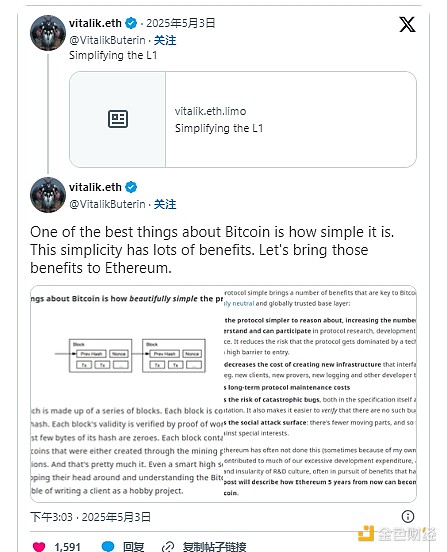
1. Simpler consensus layer
In order to simplify consensus, Buterin pointed out the new Beam Chain proposal, which advocates replacing the old, complex system with a simpler design:
A leaner core with three-slot finality: Technical systems such as cycles, committee reorganizations, and synchronization committees are eliminated, making the consensus engine easier to understand, audit, and maintain.
Simpler fork choice rule:Reduces the number of active validators at any one time, reduces the complexity of deciding which version of the chain to follow, and improves security.
Simpler vote collection (based on STARKs):Makes it easier and more economical to collect validator votes without trusting specific participants or dealing with duplicate data.
Clearer validator lifecycle:Makes validator joining, exiting, key renewal, and offline recovery more straightforward, reduces edge cases, and helps the network define clearer safety windows.
Simplified peer-to-peer communication:Fewer protocol components make it easier for nodes to connect, sync, and stay consistent.
2. Simpler Execution Layer
Vitalik reiterated his support for replacing Ethereum’s current virtual machine, the EVM, with a simpler, more modern RISC-V alternative, which he believes is bloated and hinders scalability.
For those who missed our article on RISC-V, this general-purpose virtual machine can be thought of as Linux for hardware: a concise open source blueprint that has been used by companies such as Intel and Arm to build chips. In Ethereum, it will serve as the new smart contract engine, providing the following advantages:
Simpler virtual machine specification:Easier to understand than EVM, less buggy, easier to upgrade, and better suited for long-term maintenance.
Fewer special case shortcuts (precompiled):Replaces most built-in functions with regular smart contract code, streamlining the base protocol and making it easier to maintain.
Already used in ZK:Since RISC-V accelerates zero-knowledge proofs, it has been adopted by projects like Polygon, Risc Zero, and SP1.
More flexible languages:Developers can use languages like Rust or Move, not just Solidity.
Vitalik sees this as an opportunity to rebuild the foundations better, potentially improving its performance by 100x.
3. Backwards-compatible transition
What happens to all the apps and tools that still rely on the EVM? Vitalik has laid out a phased transition plan designed to keep everything working without forever burdening the base protocol with legacy baggage.
The goal: move legacy features out of the core protocol, where they still work but don’t weigh down Ethereum. Just like storing old files in the cloud, they’re still available if needed but don’t take up space on your desktop. This keeps the core protocol lean while retaining compatibility with all existing builds. Here’s what he proposes:
Start with RISC-V precompilations:New features will be built using RISC-V, allowing the ecosystem to better adapt to the virtual machine.
Support both virtual machines:During the transition, developers can deploy in either the EVM or RISC-V with full cross-compatibility.
Replace precompiled code with RISC-V code:Replace most built-in functions with simple on-chain RISC-V code, reducing protocol bloat.
Encapsulate EVM into contracts:Migrate the EVM into RISC-V smart contracts, meaning old logic can still run but won’t interfere with the most sensitive parts of the protocol.
This way, Ethereum can clean up its foundations without destroying what’s already been built.
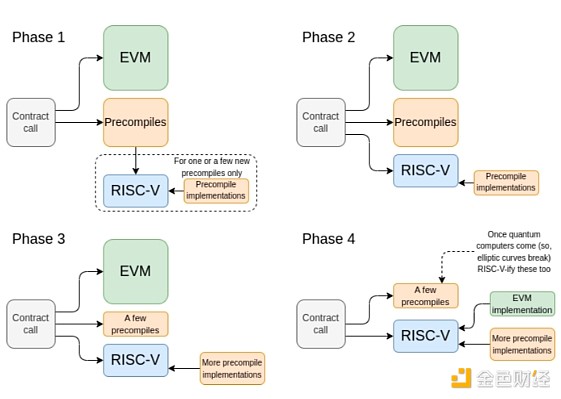
4. Shared standards = reduced complexity
Finally, Vitalik wants to simplify Ethereum by standardizing tools across the network.
Currently, different parts of the protocol often solve the same problem in slightly different ways - mainly because various teams build them independently. Unifying these parts under shared standards can reduce complexity and make the entire stack easier to maintain. His proposal is:
A unified shared code system (SSZ):Already used at the consensus layer to track network state. Expanding this across Ethereum would simplify tooling and make applications easier to build and connect.
A unified approach to data splitting (erasure coding):Ethereum splits and verifies data in multiple aspects: data availability sampling, P2P broadcasting, and history storage. Using the same approach everywhere reduces the amount of code, increases speed, and ensures data verification is accurate.
A unified state structure (tree structure):Replacing the current complex Merkle data tree with a simpler binary data tree would save space, speed up proofs, and help lightweight applications run more efficiently.
These small changes may not sound dramatic, but they reduce the overall weight of the system—making Ethereum easier to run and harder to hack.
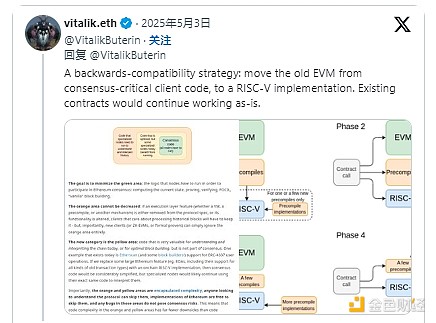
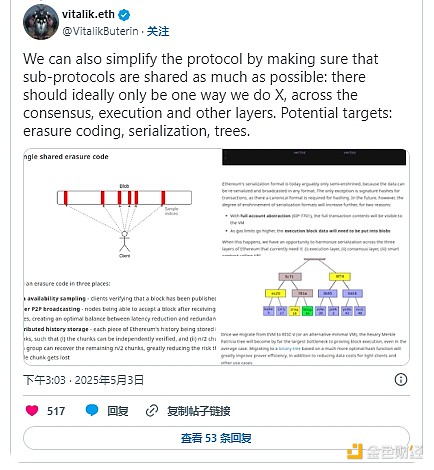
In summary, Ethereum’s advantage has always been its flexibility—but this also comes with growing complexity.
Vitalik’s vision aims to restore simplicity without losing power, making Ethereum leaner, cleaner, and easier to build on. If Ethereum is to support the world’s most important data and systems, it needs to be not only scalable, but also durable.
Vitalik believes that to achieve this, it must first be lean.
 Hui Xin
Hui Xin
 Hui Xin
Hui Xin Clement
Clement Brian
Brian Aaron
Aaron Jixu
Jixu Jasper
Jasper Clement
Clement Kikyo
Kikyo Jixu
Jixu Clement
Clement